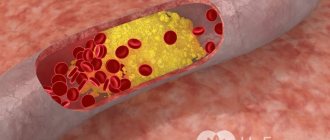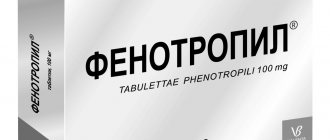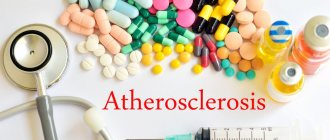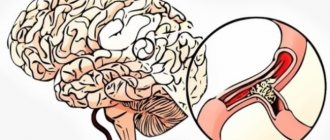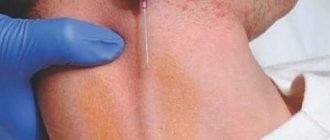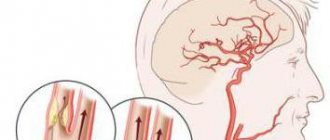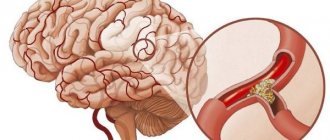Does it make sense to treat cerebral vessels with folk remedies? This issue needs to be approached more thoroughly and all prescriptions must be coordinated with your doctor.
More recently, people of the older generation were treated with vascular problems, but now you can often meet young people under the age of 30. What will happen in 20-30-40 years? It's scary to think about this question.
How to treat cerebral vessels using traditional methods
Today we will talk about not entirely traditional ways to eliminate complications that arise, namely, we will consider the treatment of cerebral vessels using traditional methods, because this organ is responsible for vital processes and the issue of its normal blood circulation is relevant.
Honey for vascular atherosclerosis
Honey has pronounced antioxidant properties and helps the body cleanse itself of waste and toxins. It reduces the level of “bad” cholesterol in the blood and accelerates metabolic processes occurring in the body.
Honey contains trehalose, a natural sugar that is an excellent preventative against heart attacks. This substance helps cleanse the inner surface of blood vessels, as it activates immune cells and encourages them to remove fatty deposits that accumulate on the inner surface of the arteries.
Experts advise eating 1 teaspoon of honey every day to prevent the occurrence and development of atherosclerosis. If the disease has already begun to affect the blood vessels, then you need to prepare a healing honey-beet mixture . Mix 200 ml (1 glass) of freshly squeezed beet juice with 100 ml (1÷2 glasses) honey. Take the product 3 times a day, 1 tablespoon immediately after meals.
To prepare a medicinal mixture of black radish juice and honey , you need to mix 1 glass (200 ml) of honey with 1 glass (200 ml) of freshly squeezed radish juice. The prepared mixture should be taken daily, 1 tablespoon after meals 3 times a day.
Folk remedies
Treatment of the disease must be comprehensive. And in addition to proper diet and medications, doctors widely use folk remedies to treat cerebral atherosclerosis and recommend their use to patients.
Depending on the stage of this pathology, treatment with traditional recipes can be used as the main method of treatment or as an auxiliary one. Depending on the mechanisms and causes of atherosclerosis, plants with anti-sclerotic and vasodilating properties are used. In addition, plants are chosen that are rich in vitamins.
But it is unacceptable to immediately rush to the pharmacy at the first signs of the disease and buy all the folk remedies for atherosclerosis there. First you need to talk to your doctor and undergo an examination.
Only a doctor can prescribe medications for cerebral atherosclerosis.
Among folk methods there are many different recipes, as well as various methods of treatment.
Several recipes for folk remedies for atherosclerosis that can be taken to treat the disease are written below.
5 g of hawthorn flowers are poured into a glass of boiling water, as when brewing tea, and covered with a lid. The mixture is heated using a water bath for a quarter of an hour. After this, it is cooled and filtered. The remainder is squeezed out and thrown away. The amount of liquid is brought to a glass. You need to take half a glass 2 times before meals.
Take a tablespoon of buckwheat flowers, brew 400 ml of boiling water and then let it brew for at least two hours. After the specified time has expired, filter the mixture and take half a glass four times a day, regardless of meals. This infusion has a calming effect on the nervous system and also lowers blood pressure. You can add a little cucumber herb to the buckwheat flower.
Elecampane roots in an amount of 30 g are crushed, poured with vodka (0.5 l) and left to infuse in the dark for 40 days. Then you need to drink the tincture before sitting down to eat, 25 drops. It relieves symptoms such as headache and weakness.
In strawberries, you can use not only the berries, but also the leaves, fresh and dry, and even the rhizomes. Take one teaspoon of roots per glass of boiling water. Boil them for a quarter of an hour, then add a small spoonful of leaves. Leave for about an hour and drink in three doses. This infusion reduces the amount of cholesterol in the body.
Onion juice (take onions) is diluted with honey in a 1:1 ratio and then taken a tablespoon no more than 5 times a day. Sugar is often used instead of honey. But it should be remembered that this remedy cannot be used by diabetics.
Decoctions and infusions of lemon balm (melissa) relieve spasms of axon endings, improve brain functioning, reduce the frequency of dizziness and the severity of tinnitus. This herb is used for medicinal purposes in any form - fresh and dry. You can only collect flowers, but you can also collect leaves. Stems will also work. And no special preparation standards are required either. It is often drunk as tea.
Everyone knows seaweed too. It can be consumed in salads, or you can prepare a decoction of dry cabbage and drink it no more than 3 times a day along with soup. It is also permissible to mix this decoction with juices or water. Proportions are not important here.
Walnut fruits should be eaten about 100 g every day. They are useful not only for atherosclerosis. They are also recommended for those suffering from cardiosclerosis and hypertension. You can also infuse young leaves of the plant by taking a tablespoon of leaves in half a liter of boiling water and leaving for about an hour. This infusion is drunk half a glass at least three times.
A strong infusion or decoction of parsley herb is used not only for atherosclerosis. It is also recommended for those suffering from stone disease of the renal system, gall and bladder or other organs.
Plantain leaves are used dry. They are crushed and brewed for ten minutes, taking a tablespoon per 0.2 liter of water.
Fresh pine needles are often used to treat pathology. For this purpose, the glass is filled to the top with raw materials. They do not need to be compacted. Then the needles in the glass are poured with vodka until completely covered. Insist for ten days in the dark, closing the glass. After a ten-day period, the liquid is decanted and about ten drops are taken, diluting them in a tablespoon of boiled water, three times a day before meals.
Rowan bark is also often taken to treat the disease. To do this, take 200 grams of chopped bark and half a liter of water. Boil the mixture over low heat for about two hours. After cooling, the liquid is taken in the amount of a tablespoon three times a day, about half an hour before meals.
When treating the disease, you can use the collection of red hawthorn fruits, chokeberry fruits and strawberry fruits, taking each part in a 1:1:1 ratio. Mix everything left over thoroughly, take a couple of tablespoons, add half a liter of hot boiled water and heat in a water bath for half an hour. After this, the mixture is cooled, filtered and the amount of liquid is adjusted to half a liter. Take half a glass of the decoction three times a day, regardless of meals. The fruits can be taken dry or fresh.
The horseradish roots are washed, grated with a grater, then take 0.250 g and pour 3 liters of hot water. Then the mixture is placed on low heat and boiled for about a third of an hour. After cooling, the broth is filtered through a strainer or cheesecloth and drunk 3 times a day, regardless of meals, half a glass. Taking this medication should last two to three weeks. It should be recalled that the decoction of horseradish roots must be poured after cooling into a glass container, pre-treated with boiling water, and placed in the refrigerator.
Garlic can be used for the treatment and prevention of atherosclerosis and hypertension by preparing it according to various recipes. For example, after grinding a head of garlic, put it in a jar and fill it with a glass of vegetable oil. For this purpose, take a medium head of garlic and unrefined oil. Insist, shaking occasionally, for a day. Then add lemon juice to the mixture, mix well and then leave for another week in the dark. Can be in the refrigerator. Take the resulting infusion three times a day, a teaspoon half an hour before meals. This mixture can be used for a month. You can also use another recipe, it will require 300 g of peeled garlic. It is washed and placed in a glass half-liter jar, after which it is filled to the top with alcohol. The alcohol infusion is prepared for 3 weeks, after which it can be taken 20 drops with half a glass of milk. You can also infuse garlic in vodka. But here the recipe is slightly different: a half-liter bottle is filled halfway with garlic, previously crushed in any way, filled to the top with vodka and left in the dark for 12 days, shaking every day. Take 5 drops of this infusion a quarter of an hour before meals, mixed with a teaspoon of water. To prevent atherosclerosis, you can eat 2–3 cloves every day.
The simplest recipe for preparing garlic to treat atherosclerosis is to use it with honey. In this case, the main ingredient is mixed with honey in a 1:1 ratio and eaten or drunk 3 to 4 times before eating.
The bark with the roots of Eleutherococcus, which is collected in the spring or after the leaves have fallen off, is crushed, vodka is added to them (by weight exactly as much as the roots or bark were taken). The mixture is infused until the liquid acquires a dark tint and a sweet aroma. The product gives a good anti-sclerotic effect if taken 30 drops three times a day before meals. Tincture of the bark or roots of this plant reduces the concentration of cholesterol in the body, improves memory and the condition of blood vessels in the cerebral cortex. In addition, taking the tincture improves vision, hearing and improves immunity.
Rosehips can be crushed and then filled into two-thirds of a half-liter bottle. After this, pour vodka, filling to the top. Infuse the rose hips in the dark for two weeks, shaking them every day. Take 20 drops of the tincture, dropping 20 drops onto a piece of sugar. You can also infuse whole rose hips. But in this case, you need to take the tincture a little differently. Start taking it with 5 drops, and then increase the amount by another 5 drops every day. So the dose is increased to 100 drops, and then gradually reduced to 5. This is followed by a break.
The roots of blue cyanosis can be used for treatment. They are crushed, then take two tablespoons of the raw material, pour half a glass of burning water, then boil the mixture for 10 minutes in a water bath, filter. Take this remedy one tablespoon five times after meals.
Dill can also significantly improve the patient's condition. To do this, prepare an infusion in the amount of a tablespoon of dry herb per half liter of boiling water, which is left to infuse for half an hour. You should drink half a glass of infusion. You can also take a tablespoon of seeds crushed in a coffee grinder or hand mill, pour in 0.2 liters of boiling water, leave for half an hour and drink no more than a couple of tablespoons four times a day.
A mixture of dandelion roots, wheatgrass rhizomes, cinquefoil leaves and any parts of yarrow herb can also help with this pathology. To do this, take 10 g of each part. Then brew a tablespoon of the herbal mixture with a glass of hot water, leave for about an hour and then drink three-quarters of a glass in the morning on an empty stomach.
For medicinal purposes, take a kilogram of fruits such as raisins, dried apricots, prunes, figs and rose hips. All dried fruits are placed together in a large saucepan, filled with water to the level of the berries and placed in a cold place to soak. In the morning, the infused fruits are minced in a meat grinder. Store the mixture in a cool place. Can be in the refrigerator. Eat it in the amount of a tablespoon per day, preferably in the morning.
For the treatment and prevention of atherosclerosis, people who have crossed the age of forty, experts recommend consuming raw potatoes on an empty stomach. Or rather, their juice, which is pre-stirred, is recommended.
It is also useful to drink three tablespoons of vegetable oil (preferably from olive or sunflower) in the morning. This technique helps in the prevention of atherosclerosis.
A mixture of squeezed lemon and orange juices is diluted with hot water (about a glass). It is beneficial to take this diluted juice every day on an empty stomach. But half an hour before breakfast, it is recommended to drink a quarter glass of fresh red currant juice.
If there is a desire and time, some patients make infusions from a mixture of herbs. For example, such collections as clover grass, strawberries, lemon balm, birch leaves, pink petals and hawthorn flowers, as well as oat straw and raspberry roots are quite popular. The mixture is brewed like tea. The fees are often used without a break for months. They alternate every couple of months.
The disease also recedes with daily consumption of 100 g of cottage cheese, apples, oranges and lemons.
The development of atherosclerosis occurs slowly. At the same time, no symptoms of damage to the cerebral vessels appear for a long time, until at some point it suddenly manifests itself. But in this case it is already too late to treat it. For many months, and sometimes even years, the disease works to narrow the blood vessels, leading to the settling of various blood particles on their walls. The coronary arteries, which are responsible for the normal functioning of the myocardium, are especially often affected by this disease. Clogged arteries lead to heart attacks, myocardial infarction, and often the death of the patient.
If traditional methods of treatment or preventive measures prescribed by a cardiologist are included in the treatment in a timely manner, this disaster can be avoided. It’s even better to carry out prevention in advance. An active lifestyle should be important.
Olive oil
Official statistics state that regular consumption of olive oil reduces mortality from cardiovascular diseases by 8–10%! And this is not surprising, because olive oil fights the formation of blood clots, strengthens the walls of blood vessels, cleanses the arteries of “garbage” in the form of fatty deposits, making them elastic and durable.
Olive oil contains linoleic acid, which, without affecting “good” cholesterol, significantly reduces the level of “bad” cholesterol. Linoleic acid not only regulates cholesterol levels in the blood, but also promotes the synthesis of sex hormones and the formation of new cells.
Olive oil has a beneficial effect on the functioning of the heart, as it becomes much easier and easier for it to pump blood through clean and elastic arteries. People who regularly consume olive oil have improved memory, headaches, weakness and dizziness disappear, and the risk of developing Alzheimer's disease is reduced several times.
If you have already been diagnosed with atherosclerosis, then for 14 days immediately after waking up, you need to slowly move 1 teaspoon of olive oil at room temperature for 2 to 3 minutes in your mouth and then spit it out. After 30 - 35 minutes, the above steps should be repeated again. You can have breakfast only 60–80 minutes after the procedure.
If during the procedure or immediately after it you feel nausea, then experts advise adding 2 to 3 drops of freshly squeezed lemon juice or honey to the olive oil.
If you do not have obvious signs of atherosclerosis, but you want your blood vessels to be clean and elastic until old age, then you should consume at least 30 g (2 tablespoons) of olive oil per day. Add it to salads, prepared meals, vegetables and herbs.
Why cleanse the blood vessels of the brain?
So, why is it so important to clean blood vessels, including preventive cleaning? The pathology, as a rule, is associated with a violation of fat (lipid) metabolism; at the same time, the lumen of the cerebral vessels narrows due to the proliferation of connective tissue, the deposition of calcium salts and solid fats, including cholesterol.
However, this process develops quite slowly, and in the initial stages it is virtually asymptomatic. At this stage, the body no longer receives enough oxygen and nutrients carried throughout the body by the blood flow. Due to the turbulence of the riverbed, aggravating the situation, blood clots form that can break off and clog the arteries.
Even when in an attached state, such a clot blocks the blood flow, thereby causing necrosis of tissues deprived of nutrition, but with physical exertion, a sharp increase in pressure, stress or hyperthermia of the body, the clot clogs a cerebral artery, leading to a stroke.
And such a process can begin due to atherosclerosis, the main prerequisites for the development of which are:
- an increased concentration of cholesterol is, perhaps, the main factor; other solid substances are also deposited on the wall tissues - lipoproteins and triglycerides;
- the development of a dangerous phenomenon is facilitated by obesity, in particular as a result of a disease such as diabetes;
- high blood pressure and hypertension worsen the condition of cerebral vessels, which contributes to the accumulation of harmful deposits in them;
- genetic predisposition, for example, hypercholesterolemia in relatives;
- the presence of diseases of the endocrine system;
- increased level of blood density and its rapid clotting, that is, thrombophilia.
It is worth adding that physical inactivity and harmful addictions – smoking and alcohol abuse – are considered provoking factors.
Pathological metamorphoses with arteries during atherosclerosis occur in stages:
- first, it is the accumulation of atherogenic fats in the blood, which provoke the occurrence of hyperlipidemia;
- excess cholesterol forms nodules and larger plaques in the cerebral arteries;
- accompanied by the accumulation of an inflammatory process in the walls and transformation into atherosclerotic deposits;
- calcium is deposited on their surface, they are capable of rupturing - this is how blood clots form;
- Subsequently, obliteration occurs - blocking of the vascular lumens, which is dangerous due to spontaneous ruptures of the arteries.
As a result, blood flow decreases and necrosis of brain tissue begins.
Depending on the different stages of atherosclerosis, a person experiences negative changes in his well-being to a greater or lesser extent.
Most often, the observed signs of the disease:
- memory impairment, problems concentrating;
- tremors of the arms, legs and chin;
- fatigue and general weakness;
- headache;
- facial distortion;
- decreased intellectual abilities;
- mental disorders, low stress tolerance;
- deterioration in the acuity of sound and auditory perception;
- increased sweating and hot flashes to the head and face;
- paresis of the limbs and half of the body;
- sleep disturbance, waking up in the middle of the night, nightmares;
- problems with orientation, impaired motor function, unsteady walking;
- disturbance of speech function and gait.
Of course, the symptoms of the disease manifest themselves individually in all people, but with serious disorders of the cerebral arteries, almost all patients can feel severe pain in different areas of the head, which only increases over time. At the same time, motor function slows down and coordination is impaired.
At the primary stage, the disease has no obvious signs, with the exception of quickly occurring fatigue and headaches that occur periodically. Most often, a person gets tired after little physical exertion, has trouble falling asleep, and his ability to work gradually decreases.
When the disease begins to progress, these symptoms include nervous disorders, dizziness, tearfulness, constant irritation, unclear articulation and an unsteady gait.
When the development of atherosclerosis reaches its apogee, loss of self-care skills, memory loss, and paralysis are possible. The consequences of such conditions are discirculatory encephalopathy, chronic ischemia with episodes of acute cerebrovascular accidents and stroke.
Therefore, it is important to cleanse the blood vessels of the brain and the entire body in advance to prevent such phenomena.
Hawthorn
Hawthorn can rightfully be called one of the most effective herbal remedies that actively help the body fight atherosclerosis. Hawthorn selectively dilates blood vessels, reduces the level of “bad” cholesterol in the blood, improves blood flow, prevents the formation of fatty plaques, and normalizes blood clotting.
Recipe No. 1 . To prepare hawthorn infusion , which perfectly cleanses blood vessels, you need to pour 3 tablespoons of dried hawthorn flowers into 600 ml (3 cups) of boiling water. The mixture must be infused for 30 - 40 minutes, then the infusion must be strained and taken 200 ml (1 glass) three times a day 30 - 35 minutes before meals.
Recipe No. 2 . To prepare a healing decoction of hawthorn fruits , pour 1 tablespoon of crushed fruits into 500 ml (2.5 cups) of boiling water, add 2 tablespoons of sugar and simmer over low heat for 40 - 45 minutes until the amount of liquid is reduced by half . The finished broth should only be stored in the refrigerator!
You need to take a decoction of hawthorn fruit three times a day, 1 tablespoon immediately before meals and 2 tablespoons before bed.
Balanced diet
Atherosclerosis of cerebral vessels when treated with folk remedies or medications requires lifestyle changes, sometimes radical. This is necessary to remove the causes that led to the narrowing of blood vessels in a “natural” way. Arteries become narrowed due to excessive consumption of fatty foods loaded with cholesterol. Therefore, if you do not break this vicious circle, none of the most effective medications will help.
Therefore, the first step on the path to recovery is to give up animal fats in favor of vegetable fats. Then, you need to add fiber, coarse dietary fiber, which will clean the digestive tract at the clearing company level and ensure normal and regular bowel movements. To do this, you should give preference to fruits and vegetables in your daily diet. Baking should give way to whole grain bread or wheat bread made from wholemeal flour.
There is a whole group of products that are designed to break down fat: lean fish, buckwheat, apples, dairy products, greens. Only by following such a diet can you count on getting rid of excess cholesterol using folk recipes.
The method of preparing food should also change: no fried, smoked, canned food. Only food that is steamed, oven-baked, or boiled. Eat five to six meals a day, in small portions, otherwise fats simply will not have time to be absorbed and will begin to be deposited in the form of atherosclerotic plaques.
Herbal infusions
Recipe No. 1. To prepare an effective and healthy herbal mixture that will help cleanse the walls of blood vessels from fatty deposits and improve the functioning of the cardiovascular system, you should take 3 parts of hawthorn flowers, 2 parts of thyme herb, 1 part of rose hips, 1 part of motherwort herb, 3 parts of herb cudweed, 3 parts string grass. All ingredients must be mixed thoroughly. 1 tablespoon of the resulting herbal mixture should be poured with 500 ml of boiling water and left for 25 to 30 minutes. You should drink tea 4–6 times a day, 100 ml (1÷2 glasses).
Recipe No. 2 . To prepare this popular and effective herbal mixture, you need to mix 3 parts of currant leaves, 1 part of nettle leaves, 1 part of horsetail herb, 3 parts of string herb, 2 parts of St. John's wort, 2 parts of clover flowers, 2 parts of horse chestnut flowers, 3 parts of strawberry leaves . 1 tablespoon of the prepared herbal mixture must be poured with 500 ml of boiling water and infused for 25 - 30 minutes. Ready-made tea should be drunk 100 ml (1÷2 glasses) 4 – 5 times a day.
If a person suffering from atherosclerosis experiences hypotension, then hawthorn and rose hips must be replaced with viburnum.
When can you treat at home?
The patient may not experience symptoms at first. In the future, the disease can manifest itself in different forms, depending on the degree and stage of organ damage. If you feel pain (signs of coronary artery disease), it is important to consult your doctor in time and clean the blood vessels. Heart problems manifest themselves in the form of angina pectoris, chest discomfort, acute coronary insufficiency, which leads to death. It is necessary to sound the alarm at the moment when a person has the following complaints:
- obvious memory impairment;
- decreased concentration;
- difficulty learning new information;
- increased pain in the heart when moving;
- manifestation of weakness in the limbs;
- trophic ulcers;
- gangrene.
Garlic for vascular atherosclerosis
Garlic has anti-sclerotic, tonic, vasodilating, antioxidant properties, so it is widely used to combat atherosclerosis. It reduces the level of “bad” cholesterol in the blood, cleanses and strengthens the walls of blood vessels, lowers blood pressure, normalizes metabolic processes occurring in the human body, prevents the formation of blood clots, improves the functioning of the cardiovascular system, and normalizes blood circulation.
To prepare garlic tincture , which is great for atherosclerosis, you should take ground garlic cloves and fill it halfway with peeled and finely chopped walnuts, and then pour unrefined “fragrant” sunflower oil into it. The mixture should be consumed in 20 - 30 grams, and can also be used as a sauce for vegetable salads.
Juice treatment
To speed up the breakdown and destruction of cholesterol deposits on the walls of blood vessels, the body must contain antioxidants, vitamins B, C and PP and minerals. You can get a large amount of the necessary components from vegetable juices. To prepare them, you can use pumpkin, celery, beets, potatoes, carrots, onions, and cabbage.
For the most successful cleansing of brain vessels, such drinks should be consumed at least once a day. This therapy has no side effects, so you can drink juices for as long as you like.
Ginger
Ginger is another excellent herbal remedy that has a beneficial effect on the cardiovascular system and helps cleanse the arteries of old fatty deposits. Ginger contains vitamins, phytoncides, gingerol, trace elements, organic acids that saturate the heart with essential substances, thin and cleanse the blood, reduce the amount of “bad” cholesterol in the blood, dissolve fatty deposits in blood vessels, and normalize lipid metabolism and blood pressure. Ginger is an excellent prevention of the occurrence and development of atherosclerosis, strokes and heart attacks.
Ginger tea perfectly cleanses blood vessels and prevents the development of atherosclerosis. To prepare tea with ginger, you need to pour 2 tablespoons of finely grated ginger root into 1 liter of boiling water. When the tea has cooled to room temperature, you can add honey or a little lemon juice. The finished drink should be drunk throughout the day until it runs out.
Useful herbs
Atherosclerosis of cerebral vessels can also be treated at home with the help of medicinal plants. Herbs are used as an additional means to enhance the effect of medications.
But you should not use only one plant, because if you pay attention to the mechanism of development of the disease, you can understand that several herbs will help cope with the disease, which:
- help improve lipid metabolism;
- increase the lumen of blood vessels;
- help avoid vasospasm;
- prevent the development of oxygen starvation;
- reduce blood thickness;
- tone the heart muscle;
- have a calming effect;
- saturate the body with vitamins and minerals.
From this we can conclude that to improve the condition, you need to use only multi-component herbal mixtures from several plants.
Flax seeds
The composition of flax seeds includes phenol carbonic and organic acids, linamarin, methyl fat, omega-3 acids, which help reduce the level of “bad” cholesterol in the blood, strengthen the walls of blood vessels and cleanse them of fatty deposits. Flax seeds remove waste and toxins from the body, reduce the concentration of lipids in the blood and improve heart tone.
Flaxseeds are actively used for the prevention and treatment of atherosclerosis. To prepare a healing infusion of flax seeds , you need to grind 2 tablespoons of flax seeds in a coffee grinder and mix them with 1 tablespoon of ground dried calendula flowers, which are sold at any pharmacy. The mixture of flax seeds and calendula flowers should be poured with 200 ml (1 glass) of water at room temperature, and then left to infuse for 40 - 50 minutes.
The finished infusion, filtered through several layers of gauze or a special mesh, should be taken 50 - 70 ml (1÷3 cups) 3 times a day immediately before meals for 14 - 16 days, after which you need to take a seven-day break, since the excess omega- 3 acids can harm the body.
Rose hip
Rosehip not only contains a record amount of vitamin C (40 times more than citrus fruits!), but also improves the condition of the cardiovascular system, cleanses the blood and vessel walls of fatty plaques, increases hemoglobin levels, lowers blood pressure, and is an excellent prevention of the occurrence and development of atherosclerosis. Rosehip strengthens the walls of blood vessels, reduces their fragility and permeability, and returns them to their former elasticity.
Rosehip tea for atherosclerosis . To prepare tea, you need to pour 2 tablespoons of crushed dried rose hips into 400 ml (2 cups) of boiling water, and then steam in a thermos for 6 - 7 hours. Tea should be drunk 3 times a day, 200 ml (1 glass) for 14 - 16 days.
If you find an error, please select a piece of text and press Ctrl+Enter.
Symptoms of atherosclerosis
Symptoms begin to appear small, gradually increasing and aggravating, this is due to the growth and large number of atherosclerotic plaques.
The main and most common symptoms:
- frequent headaches, manifested with varying intensity, and accompanied by tinnitus; problems with sleep, difficulty falling asleep, frequent awakenings in the middle of the night, resulting in drowsiness throughout the day;
- anxiety, increased excitability and aggression;
- performance decreases, fatigue is felt;
- even with smooth movements, changing body position, dizziness is present;
- memory and concentration decrease;
- coordination and movements become slow;
- speech is protracted, slow, unclear;
- increased sweating;
- hypertension;
- difficulty swallowing;
- convulsions of the upper and lower extremities.
This is the most basic part of the manifestations of the disease; if timely, adequate treatment is not provided, the person may completely lose memory and spatial orientation, and there is also a high probability of developing a stroke with all its negative aspects.

